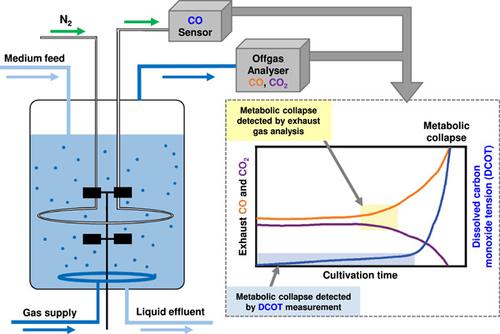当前位置:
X-MOL 学术
›
Biotechnol. Bioeng.
›
论文详情
Our official English website, www.x-mol.net, welcomes your feedback! (Note: you will need to create a separate account there.)
Online measurement of dissolved carbon monoxide concentrations reveals critical operating conditions in gas fermentation experiments.
Biotechnology and Bioengineering ( IF 3.8 ) Pub Date : 2020-09-17 , DOI: 10.1002/bit.27567 Marcel Mann 1 , Katharina Miebach 1 , Jochen Büchs 1
Biotechnology and Bioengineering ( IF 3.8 ) Pub Date : 2020-09-17 , DOI: 10.1002/bit.27567 Marcel Mann 1 , Katharina Miebach 1 , Jochen Büchs 1
Affiliation

|
Syngas fermentation is one possible contributor to the reduction of greenhouse gas emissions. The conversion of industrial waste gas streams containing CO or H2, which are usually combusted, directly reduces the emission of CO2 into the atmosphere. Additionally, other carbon‐containing waste streams can be gasified, making them accessible for microbial conversion into platform chemicals. However, there is still a lack of detailed process understanding, as online monitoring of dissolved gas concentrations is currently not possible. Several studies have demonstrated growth inhibition of Clostridium ljungdahlii at high CO concentrations in the headspace. However, growth is not inhibited by the CO concentration in the headspace, but by the dissolved carbon monoxide tension (DCOT). The DCOT depends on the CO concentration in the headspace, CO transfer rate, and biomass concentration. Hence, the measurement of the DCOT is a superior method to investigate the toxic effects of CO on microbial fermentation. Since CO is a component of syngas, a detailed understanding is crucial. In this study, a newly developed measurement setup is presented that allows sterile online measurement of the DCOT. In an abiotic experiment, the functionality of the measurement principle was demonstrated for various CO concentrations in the gas supply (0%–40%) and various agitation rates (300–1100 min−1). In continuous stirred tank reactor fermentation experiments, the measurement showed reliable results. The production of ethanol and 2,3‐butanediol increased with increasing DCOT. Moreover, a critical DCOT was identified, leading to the inhibition of the culture. Thus, the reported online measurement method is beneficial for process understanding. In future processes, it can be used for closed‐loop fermentation control.
中文翻译:

溶解一氧化碳浓度的在线测量揭示了气体发酵实验中的关键操作条件。
合成气发酵是减少温室气体排放的一种可能因素。通常燃烧的含有 CO 或 H 2的工业废气流的转化直接减少了向大气中排放的 CO 2。此外,其他含碳废物流可以气化,使微生物可以将其转化为平台化学品。然而,仍然缺乏详细的过程理解,因为目前无法在线监测溶解气体浓度。多项研究表明杨氏梭菌的生长抑制作用在顶部空间的高 CO 浓度下。然而,生长不受顶部空间中 CO 浓度的抑制,而是受溶解的一氧化碳张力 (DCOT) 的抑制。DCOT 取决于顶部空间中的 CO 浓度、CO 传输速率和生物质浓度。因此,DCOT 的测量是研究 CO 对微生物发酵的毒性作用的一种优越方法。由于 CO 是合成气的组成部分,因此详细了解至关重要。在这项研究中,提出了一种新开发的测量设置,允许对 DCOT 进行无菌在线测量。在非生物实验中,测量原理的功能在气体供应中的各种 CO 浓度(0%–40%)和各种搅拌速率(300–1100 min -1)。在连续搅拌釜反应器发酵实验中,测量显示出可靠的结果。乙醇和 2,3-丁二醇的产量随着 DCOT 的增加而增加。此外,确定了一个关键的 DCOT,导致文化的抑制。因此,报告的在线测量方法有利于过程理解。在未来的过程中,它可以用于闭环发酵控制。
更新日期:2020-09-17
中文翻译:

溶解一氧化碳浓度的在线测量揭示了气体发酵实验中的关键操作条件。
合成气发酵是减少温室气体排放的一种可能因素。通常燃烧的含有 CO 或 H 2的工业废气流的转化直接减少了向大气中排放的 CO 2。此外,其他含碳废物流可以气化,使微生物可以将其转化为平台化学品。然而,仍然缺乏详细的过程理解,因为目前无法在线监测溶解气体浓度。多项研究表明杨氏梭菌的生长抑制作用在顶部空间的高 CO 浓度下。然而,生长不受顶部空间中 CO 浓度的抑制,而是受溶解的一氧化碳张力 (DCOT) 的抑制。DCOT 取决于顶部空间中的 CO 浓度、CO 传输速率和生物质浓度。因此,DCOT 的测量是研究 CO 对微生物发酵的毒性作用的一种优越方法。由于 CO 是合成气的组成部分,因此详细了解至关重要。在这项研究中,提出了一种新开发的测量设置,允许对 DCOT 进行无菌在线测量。在非生物实验中,测量原理的功能在气体供应中的各种 CO 浓度(0%–40%)和各种搅拌速率(300–1100 min -1)。在连续搅拌釜反应器发酵实验中,测量显示出可靠的结果。乙醇和 2,3-丁二醇的产量随着 DCOT 的增加而增加。此外,确定了一个关键的 DCOT,导致文化的抑制。因此,报告的在线测量方法有利于过程理解。在未来的过程中,它可以用于闭环发酵控制。


























 京公网安备 11010802027423号
京公网安备 11010802027423号